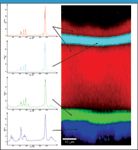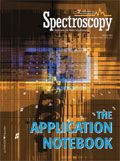Confocal Raman Imaging: Depth Profiling of Polymer Films and Coatings
WITec Instruments Corp.
Coatings and films play an important role in many fields of application (drug delivery coatings, coatings on medical devices, thin films for food protection, etc.), which makes an efficient technique for the investigation of these materials essential. Confocal Raman Microscopy is a powerful tool for nondestructively imaging the chemical composition of heterogeneous components within a film or coating. The confocal setup not only provides the highest spatial resolution, but also allows the acquisition of depth profiles ideally suited to the three-dimensional characterization of polymer films and coatings without sample preparation.

Instrumentation & Experiment
The Confocal Raman Microscope WITec CRM 200 combines a highly sensitive confocal microscope and a high-transmission Raman spectroscopy system. With a resolution down to 200 nm at each image pixel, a complete spectrum is typically acquired in only 50 ms to 100 ms. The number of image points (spectra) is limited only by the computer memory. A typical image consists of 10,000 (100 × 100) to 65,536 (256 × 256) spectra. From this multispectrum file, an image is generated by integrating over a specific Raman line or a region in all spectra. As all spectra are stored in memory, a variety of properties such as peak-width, center of mass, or peak position of certain Raman lines can be calculated from a single measurement. For depth profiling measurements, the focal plane can be moved in the z-direction when performing either x-z scans or generating x-y image stacks in the z direction.
In this experiment, the inner polymer coating of an orange juice container was investigated with the CRM 200 by performing an x-z scan with a scan range of 50 μm × 100 μm at 200 × 120 pixels (= 24,000 spectra) using a 100 × objective (NA = 1.25). For excitation, a 532 frequency doubled Nd:Yag laser was used. The acquisition time for each spectrum was only 50 ms.

Figure 1. Raman spectra (left) and Raman image (right) of the inner coating of an orange juice container.
Results
Within the acquired multi-spectrum file, four distinct spectra can be observed in Figure 1 (left). Each spectrum represents a dedicated chemical compound within the polymer film. With the integrated software tools, the distribution of each compound can be made visible by analyzing all acquired spectra. Figure 1 (right) shows the resulting color-coded image, clearly revealing that the coating consists of five different layers although only four components are involved. The software also provides the ability to measure distances within the image, indicating that all layers vary in thickness.
Conclusion
Confocal Raman Microscopy is an ideal tool for the analysis of heterogeneous samples on the submicrometer scale. As shown in the example, different polymer layers in the film can be clearly resolved and matched with their associated Raman Spectrum. Detailed information on the structure of multilayered polymer films or coatings can thus be attained using the depth profiling capabilities of the confocal Raman microscope.
WITec Instruments Corporation
101 Tomaras Avenue, Savoy, IL 61874
Tel. (877) 948-3201, Fax (217) 352-6655

Thermo Fisher Scientists Highlight the Latest Advances in Process Monitoring with Raman Spectroscopy
April 1st 2025In this exclusive Spectroscopy interview, John Richmond and Tom Dearing of Thermo Fisher Scientific discuss the company’s Raman technology and the latest trends for process monitoring across various applications.
A Seamless Trace Elemental Analysis Prescription for Quality Pharmaceuticals
March 31st 2025Quality assurance and quality control (QA/QC) are essential in pharmaceutical manufacturing to ensure compliance with standards like United States Pharmacopoeia <232> and ICH Q3D, as well as FDA regulations. Reliable and user-friendly testing solutions help QA/QC labs deliver precise trace elemental analyses while meeting throughput demands and data security requirements.